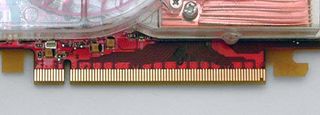Graphics Beginners' Guide, Part 1: Graphics Cards
AGP

(Accelerated Graphics Port)
AGP is a high-bandwidth interface designed specifically for graphics cards. It was based on the PCI rev. 2.1 specification. Unlike PCI, which is a shared bus, AGP is dedicated to one device. This allowed AGP to have numerous advantages over PCI such as directly read/write capabilities with the system memory, de-multiplexing or simplification in the organization and transfer of data, and increase clock speeds.
AGP has gone through three major revisions, with the newest being AGP 8x at 2,1 GB/s, meaning that it is eight times faster than the initial AGP standard at 266 MB/s (32 bit, 66 MHz). AGP is being replaced by the PCI Express interface on new motherboards, but AGP 8x (and even AGP 4x) still offer sufficient bandwidth for contemporary video cards. All AGP 8x cards will work in both AGP 4x and AGP 8x slots.
PCI Express

In contrast to ISA, PCI and AGP, PCI Express is a serial interface subsystem. Thanks to this, it runs with very few connections. Different from parallel buses, the total bandwidth is available for every device, while e.g. several PCI cards have to share the total available bandwidth.
PCI Express works on the basis of multiplying as many single links (or lanes) as required to lineup the desired bandwidth. PCI Express x1 slots are short and compact, and their connection offers 250 MB/s both ways (upstream to the system and downstream to the device). PCI Express x16 (16 links) offers a bandwidth of 4 GB/s up and down or 8 GB/s total. The inferior slot options (x8, x4, x1) are not used for graphics. A mechanical x16 slot does not necessarily have to run at 16 connected PCI Express lanes, though. There are many motherboards available that are capable of running two PCI Express x16 slots at x8 bandwidth each in order to support twin-graphics cards.
Although increased bandwidth is a welcome innovation, a more pressing need was facing the industry: power consumption. The AGP 3.0 standard (AGP 8x) could only deliver a maximum of 41.8 W (6 A from 3.3 V, 2 A from 5 V, 1 A from 12 V = 41.8 W and an additional 1.24 W could come from the 3.3 V auxiliary at 0.375 A). Video cards were introduced with dual 4 pin power sockets such as the ATI Radeon X850XT PE, which has one socket while the Nvidia GeForce 6800 Ultra has two.
Stay On the Cutting Edge: Get the Tom's Hardware Newsletter
Join the experts who read Tom's Hardware for the inside track on enthusiast PC tech news — and have for over 25 years. We'll send breaking news and in-depth reviews of CPUs, GPUs, AI, maker hardware and more straight to your inbox.
By adding the four-pin connections, manufacturers extended the life of AGP cards as each supplied 6.5A or 110.5 W from these right angle connections (12 V + 5 V or 17 V x 6.5 A = 110.5 W). Overall, PCI Express is a much simpler solution as it can deliver 75 W through the x16 connector and an additional 75 W per six-pin connection for a total of 150 W. PCI Express solved the concern for future bandwidth and the power consumption need.
-
srinivasgtl Is it possible to get different output on different output ports on the graphics card? I want to play two different streams and use the two ports of the same graphics cards to display these streams on two different TV's. Is this possible?Reply
Most Popular



